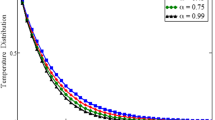Abstract
In this paper, we present a numerical model for simulating two-phase (oil–water and air–water) incompressible and immiscible flow in porous media. The mathematical model which is based on a fractional flow formulation is formed of two nonlinear partial differential equations: a mean pressure equation and a water saturation equation. These two equations can be solved in a sequential manner. Two numerical methods are used to discretize the equations of the two-phase flow model: mixed hybrid finite elements are used to treat the pressure equation, h-based Richards' equation and the diffusion term in the saturation equation, the advection term in the saturation equation is treated with the discontinuous finite elements. We propose a better way to calculate the nonlinear coefficients contained in our equations on each element of the discretized domain. In heterogeneous porous media, the saturation becomes discontinuous at the interface between two porous media. We show in this paper how to use the capillary pressure–saturation relationship in order to handle the saturation jump in the mixed hybrid finite element method. The two-phase flow simulator is verified against analytical solutions for some flow problems treated by other authors.
Similar content being viewed by others
References
Ph. Ackerer, R. Mose and P. Siegel, Reply to the comment on “Application of the mixed hybrid element approximation in a groundwater flow model: Luxury or Necessity?”, Water Resour. Res. 32(6) (1996) 1911–1913.
Ph. Ackerer, A. Younes and R. Mose, Modeling variable flow and solute transport in porous medium: 1. Numerical model and verification, Transport Porous Media 35 (1999) 345–373.
P. Binning and M.A. Celia, Practical implementation of the fractional flow approach to multi-phase flow simulation, Adv. Water Resour. 22(5) (1999) 461–478.
R.H. Brooks and A.T. Corey, Hydraulic properties of porous media, Hydrology Paper 3, Colorado State University, Fort Collins, CO (1964).
S.E. Buckley and M.C. Leverett, Mechanism of fluid displacement in sands, Trans. Amer. Inst. Min. Metall. Petrol. Engrg. 146 (1942) 107–116.
M.A. Celia, E.T. Bouloutas and R.L. Zarba, A general mass-conservative numerical solution for the unsaturated flow equation, Water Resour. Res. 26(7) (1990) 1483–1496.
G. Chavent and J. Jaffré, Mathematical Models and Finite Elements for Reservoir Simulation, Studies in Mathematics and its Applications, Vol. 17 (North-Holland, Amsterdam, 1986).
G. Chavent, J. Jaffré and J.E. Roberts, Generalized cell-centered finite volume methods: Application to two-phase flow in porous media, in: Computational Science for the 21st Century, eds. M.-O. Bristeau, G. Etgen, W. Fitzgibbon, J.-L. Lions, J. Périaux and M.F. Wheeler (Wiley, Chichester, 1997) pp. 231–241.
P.G. Ciarlet, Introduction à l'Analyse Numérique Matricielle et à l'Optimisation (Masson, Paris, 1982).
C.N. Dawson and M.F. Wheeler, Time splitting methods for advection-diffusion-reaction equations arising in contaminant transport, in: Industrial and Applied Mathematics, ed. R.E. O'Malley (SIAM, Philadelphia, PA, 1992) pp. 71–80.
L.J. Durlofsky, A triangle based mixed finite element-finite volume technique for modelling two phase flow through porous media, J Comput. Phys. 105 (1993) 252–266.
R.E. Ewing and R.F. Heinemann, Mixed finite elements approximations of phase velocities in compositional reservoir simulation, Comput. Methods Appl. Mech. Engrg. 47 (1984) 161–175.
R. Haverkamp, M. Vauclin, J. Touma, P.J. Wierenga and G. Vachaud, A comparison of numerical simulation models for one-dimensional infiltration, Soil Sci. Amer. J. 41 (1977) 285–294.
F. Lehmann and Ph. Ackerer, Comparison of iterative methods for improved solutions of the fluid flow equation in partially saturated porous media, Transport Porous Media 31(3) (1998) 275–292.
D.B. Mc Whorter and D.K. Sunada, Exact integral solutions for two-phase flow, Water Resour. Res. 26(3) (1990) 399–413.
Y. Mualem, A new model for predicting the hydraulic conductivity of unsaturated porous media, Water Resour. Res. 12 (1976) 513–522.
D. Nayagum, Simulation numérique de la pollution du sous-sol par les produits pétroliers et dérivés: Application au cas d'un écoulement monodimensionnel. Ph.D. thesis, University of Louis Pasteur, Strasbourg, France (2001).
J.R. Philips, The theory of infiltration: 1. The infiltration equation and its solution, Soil Sci. 83 (1957) 345–357.
J.R. Philips, The theory of infiltration: 2. The profile of infinity, Soil Sci. 83 (1957) 435–448.
K. Rathfelder and L. Abriola, Mass conservative numerical solutions of the head-based Richards equation, Water Resour. Res. 30(9) (1994) 2579–2586.
P.A. Raviart and J.M. Thomas, A mixed finite method for the second order elliptic problems, in: Mathematical Aspects of the Finite Element Methods, eds. I. Galligani and E. Magenes, Lecture Notes in Mathematics, Vol. 606 (Springer, Berlin, 1977) pp. 292–315.
L.A. Richards, Capillary conduction of liquids through porous mediums, Phys. 1 (1931) 318–333.
P. Siegel, R. Mosé, Ph. Ackerer and J. Jaffré, Solution of the advection dispersion equation using a combination of discontinuous and mixed finite elements, Internat. J. Numer. Methods Fluids 24 (1997) 595–613.
C.J. Van Duijn and M.J. de Neef, Self-similar profiles for capillary diffusion driven flow in heterogeneous porous media, Technical Report AM-R9601, Department of Analysis, Algebra and Geometry, Centrum voor Wiskunde en Informatica, Amsterdam, The Netherlands (1996).
C.J. Van Duijn and M.J. de Neef, Similarity solution for capillary redistribution of two phases in a porous medium with a single discontinuity, Adv. Water Resour. 21 (1998) 451–461.
M.Th. Van Genuchten, A closed-form equation for predicting the hydraulic conductivity of unsaturated soils, Soil Sci. Amer. J. 44 (1980) 892–898.
Author information
Authors and Affiliations
Corresponding author
Rights and permissions
About this article
Cite this article
Nayagum, D., Schäfer, G. & Mosé, R. Modelling Two-Phase Incompressible Flow in Porous Media Using Mixed Hybrid and Discontinuous Finite Elements. Computational Geosciences 8, 49–73 (2004). https://doi.org/10.1023/B:COMG.0000024446.98662.36
Issue Date:
DOI: https://doi.org/10.1023/B:COMG.0000024446.98662.36




